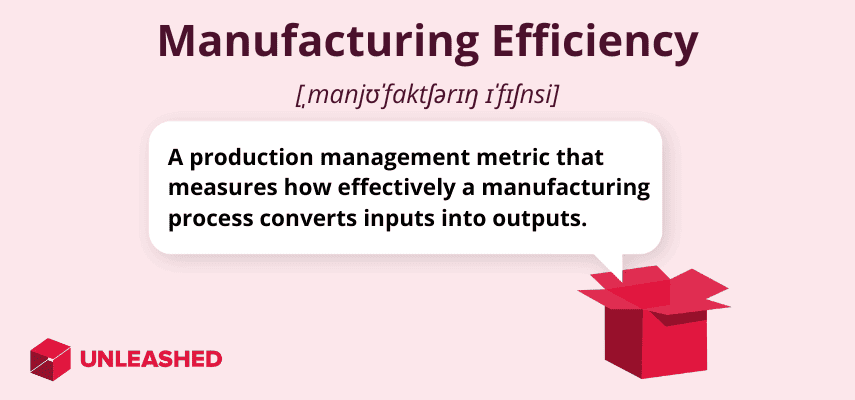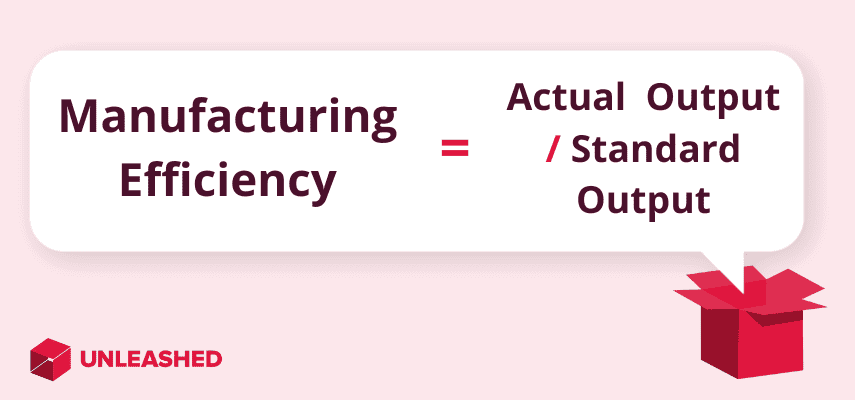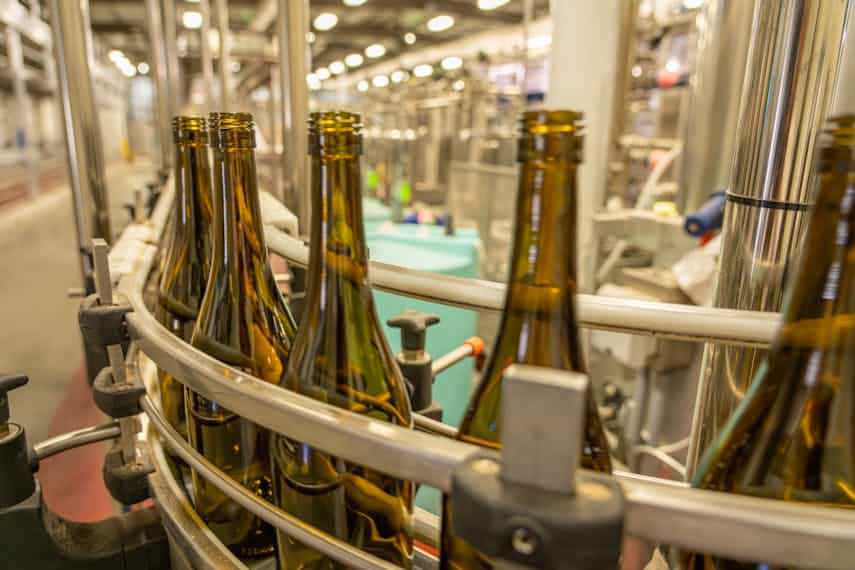
Improving manufacturing efficiency is a great way to trim down production costs. But that's not the only reason to optimise your processes. Even a small boost in efficiency can increase workplace productivity and overall product quality.
Put simply: the more efficiently you manufacture goods, the more profitable your business becomes. With the right systems in place – and continuous monitoring – you can improve manufacturing efficiency across all your key workflows.
In this guide we’ll cover the main manufacturing efficiency opportunities, why it’s important to measure efficiency, and strategies to improve operational efficiency in manufacturing.
What is manufacturing efficiency?
Manufacturing efficiency is a performance measurement that reflects how effectively a manufacturing process converts inputs – such as raw materials, labour, and energy – into outputs (finished products). Measuring efficiency helps you understand how productively your factory or production line operates and identify any opportunities for process improvement.
Let’s look at a quick example.
Imagine two factories manufacturing the same type of product. In the same amount of time, and with the same resources, one factory produces twice as many products. That factory is more efficient because it's achieving more output with fewer inputs.
Efficiency in manufacturing can be improved in several ways, including:
- Optimising production processes
- Reducing waste
- Improving equipment reliability
- Enhancing workforce skills
- Utilising technology effectively
Ultimately, the better your manufacturing efficiency, the more opportunity you’ll have to lower production costs, realise higher productivity, and achieve greater competitiveness in the market.

What is good manufacturing efficiency?
Good manufacturing efficiency refers to the ability of a manufacturing operation to consistently produce high-quality products at optimal levels of productivity while minimising waste and resource consumption. It can be defined as achieving the desired output with the least amount of input – whether that's fewer raw materials, labour, time, or energy.
A manufacturing process with good efficiency operates smoothly, with minimal downtime and disruptions, while effectively utilising available resources – such as machinery and labour – to maintain product quality and meet customer demands.
Key indicators of good manufacturing efficiency include:
- High production rates
- Low defect rates
- Minimal downtime
- Economical use of materials and energy
- Streamlined workflows
- Satisfied customers
Manufacturing efficiency vs. manufacturing productivity
Manufacturing efficiency and manufacturing productivity are closely related, but they measure different aspects of the manufacturing process. Manufacturing efficiency focuses on optimising the use of resources within the production process while manufacturing productivity measures the overall output generated relative to the resources expended.
Let’s quickly break down these differences.
Manufacturing efficiency centres on how well resources are utilised to produce a given output. It measures the effectiveness of the production process in minimising waste, reducing costs, and maximising output with the available resources. Efficiency focuses on improving metrics like machine uptime, cycle time, defect rates, and utilisation of labour and equipment.
On the other hand, manufacturing productivity measures the output generated from a given input of resources. It quantifies the relationship between the amount of goods produced (output) and the resources used to produce them (inputs) – such as labour, capital, and materials. Productivity metrics may include units produced per hour, revenue per employee, or output per unit of input.
The importance of efficiency in manufacturing
Efficiency in manufacturing is important for several reasons. Firstly, it directly impacts the cost of production. By optimising processes to use fewer resources you can reduce costs and improve profitability.
Efficiency also helps maintain competitiveness. In today's global marketplace, businesses need to produce goods quickly and at competitive prices to stay ahead. Efficient manufacturing processes allow companies to meet customer demands promptly and offer competitive pricing.
Streamlined processes reduce the likelihood of errors and defects, which is why manufacturing efficiency plays a significant role in product quality – resulting in higher-quality products that meet, or even exceed, customer expectations.
Finally, efficient manufacturing promotes sustainability. By minimising waste and resource consumption, companies can reduce their environmental footprint and contribute to a more sustainable future.
 Improvements in manufacturing efficiency result in profit and revenue gains across the business.
Improvements in manufacturing efficiency result in profit and revenue gains across the business.
Types of manufacturing efficiency
The best way to measure and improve manufacturing efficiency is to first break it down into separate parts. This way, you can tailor a strategy for optimising each process and let those improvements ripple across your entire operations.
Operational efficiency in manufacturing
Operational efficiency in manufacturing refers to the ability of a manufacturing operation to utilise its processes, resources, and activities to achieve maximum output with minimal input. It involves streamlining various aspects of production – including workflows, equipment utilisation, labour management, and resource allocation – to ensure smooth and cost-effective operations.
Think of operational efficiency as getting the most bang for your buck. Operational efficiency means using your resources as effectively as possible to produce goods at the lowest possible cost, while still maintaining product quality and meeting demand.
Key aspects of improving operational efficiency in manufacturing include:
- Reducing waste
- Minimising downtime
- Improving production throughput
- Enhancing product quality
- Maximising overall productivity
Manufacturing production efficiency
Manufacturing production efficiency refers to how well a manufacturing process converts inputs into finished products. When a manufacturing operation is highly efficient, it means that it can produce more goods in less time, with fewer resources, and at lower costs.
This efficiency can be achieved through various means, such as optimising workflows, improving equipment utilisation, reducing setup times, and enhancing workforce skills.
Manufacturing production efficiency also encompasses factors like product quality, reliability, and consistency. It's not just about producing more goods; it's also about ensuring that those goods meet, or exceed, quality standards consistently.
Manufacturing cycle efficiency
Manufacturing cycle efficiency measures how effectively a manufacturing process utilises time and resources to produce goods. It's essentially a ratio that compares the value-added time in the production process to the total cycle time.
To help you make more sense of these metrics, here’s a summary:
- Value-added time: This refers to the activities that directly contribute to the creation of a product, such as actual production time.
- Total cycle time: This includes all the time it takes to complete the entire manufacturing process – including setup, waiting, and transportation times.
When the manufacturing cycle efficiency is high, it means that a significant portion of the total cycle time is spent on value-added activities. This indicates a streamlined production process.
Conversely, a low manufacturing cycle efficiency suggests that a lot of time is wasted on non-value-added activities. This can lead to inefficiencies, higher costs, and longer lead times.
Measuring efficiency in manufacturing
To measure efficiency in a manufacturing business, you must first acquire evidence of your production output, total manufacturing costs, and any other information pertaining to resources used in the production process. This data can be worked out manually or (if you’re already using cloud manufacturing software) you can access it with your system’s analytics tools.
Once you have all the key data you need, apply the manufacturing efficiency formula below.
Manufacturing efficiency formula
The manufacturing efficiency formula is a calculation used to assess how efficiently a manufacturing process is converting inputs into outputs. In essence, it compares the actual output achieved with the maximum potential output that could be achieved under ideal conditions.
Here's the manufacturing efficiency formula:
Actual Output / Standard Output = Manufacturing Efficiency
This will tell you how efficiently, as a percentage, you are producing goods.

Let's break it down:
- Actual output: This is your total input divided by your total output. It represents the quantity of products that were produced during a specific period. For example, if it costs $200 to produce 100 products, then using the above calculation, your individual product costs would be $2. This gives you the actual output that you can make each day.
- Standard output: This is your output divided by an industry or competitor benchmark. Standard output can be found by using your historical data of output, stacked against an industry standard or competitor. For example, if we used the previous example output of $2 per product, and the industry standard was $1.50 per product, then your standard output would be 1.33.
By using the manufacturing efficiency formula, you can evaluate your production performance and identify opportunities for improvement.
A higher manufacturing efficiency percentage indicates that the manufacturing process is operating closer to its full potential, while a lower result suggests that there is room for optimisation to increase output and reduce waste.
Other useful manufacturing efficiency metrics
There are some more useful manufacturing efficiency metrics to help you assess various aspects of a manufacturing operation beyond output quantity. These provide insights into different aspects of production, quality, and resource utilisation.
Other handy metrics for measuring manufacturing efficiency:
- Overall Equipment Effectiveness (OEE): OEE measures the overall performance of equipment in terms of availability, performance efficiency, and quality rate. It helps identify equipment downtime, speed losses, and defects – providing valuable insights into equipment effectiveness and potential improvements.
- First Pass Yield (FPY): FPY calculates the percentage of products that pass quality inspections without requiring rework or repair during the initial manufacturing process. It helps gauge the effectiveness of quality control measures and identify areas for improvement in production processes.
- Throughput: Throughput measures the rate at which a manufacturing process can produce output over a specific period. It indicates production capacity and helps identify production bottlenecks that may limit overall throughput.
- Inventory turnover ratio: The inventory turnover ratio measures how quickly inventory is being converted into sales. It helps assess inventory management efficiency and identify excess inventory levels or slow-moving inventory that may be tying up capital.
- Lead time: Lead time is the time it takes for a product to move through the entire manufacturing process, from order placement to delivery. It helps identify inefficiencies and bottlenecks in the production process and ensures timely delivery to customers.
- Supplier performance metrics: These metrics evaluate the performance of suppliers in terms of quality, delivery time, and cost. By monitoring supplier performance, manufacturers can ensure a reliable supply chain and minimise disruptions to production.
- Employee efficiency metrics: These metrics assess the productivity and performance of employees, such as labour utilisation, absenteeism rates, and training effectiveness. They help identify opportunities for workforce optimisation and skill development.
By tracking these additional manufacturing efficiency metrics, you can gain a comprehensive understanding of production operations and identify key areas for improvement.
 Measuring and improving manufacturing efficiency should be an ongoing process, not a one-and-done operation.
Measuring and improving manufacturing efficiency should be an ongoing process, not a one-and-done operation.
8 ways to improve manufacturing efficiency
Improving manufacturing efficiency is crucial for staying competitive and maximising profitability.
A recent Deloitte study indicated that 86% of surveyed manufacturing executives believe that smart factory solutions will be the primary drivers of competitiveness in the next five years. 83% believe that smart factory solutions will transform the way products are made in five years.
Here are 8 effective ways to improve manufacturing efficiency:
- Tighten up your processes: Identify and eliminate unnecessary steps, bottlenecks, and inefficiencies in production workflows to optimise the manufacturing process.
- Invest in technology: Adopt advanced manufacturing technologies such as automation, robotics, and digital manufacturing tools to enhance productivity, reduce manual labour, improve process control, increase throughput, and boost efficiency.
- Implement lean manufacturing principles: Lean manufacturing principles – such as continuous improvement, waste reduction, and value stream mapping – can identify and eliminate non-value-added activities in the production process.
- Train and empower employees: By providing comprehensive training and empowering employees to contribute ideas for process improvement, you’ll encourage engaged and knowledgeable employees who, in turn, are more likely to identify opportunities for efficiency gains and actively participate in implementing solutions.
- Optimise supply chain management: Strengthening collaboration with suppliers, improving logistics, and implementing just-in-time inventory practices can minimise inventory holding costs, reduce lead times, and ensure a reliable supply of materials. An efficient supply chain supports smooth production operations and reduces disruptions.
- Focus on quality control: Implement robust quality control measures to identify and prevent defects early in the production process. By maintaining high product quality, you can reduce the occurrence of rework, scrap, and customer returns – leading to cost savings and improved efficiency.
- Monitor Key Performance Indicators (KPIs): Track and analyse key performance indicators – such as OEE, throughput, and inventory turnover – to assess manufacturing performance and identify areas for improvement. Regular monitoring of KPIs enables data-driven decision-making and continuous improvement efforts.
- Embrace continuous improvement: Foster a culture of continuous improvement where employees are encouraged to seek out opportunities for efficiency gains and contribute innovative ideas. Encourage collaboration, celebrate successes, and reward improvements to sustain momentum and drive ongoing efficiency gains.
Improve manufacturing efficiency with cloud software
Cost-effective manufacturing means minimising waste and optimising production processes.
When you run your business on spreadsheets (or in your head), things can get messy fast. Inefficient workflows lead to excess downtime, production mistakes, and wasteful purchasing. All these problems have one thing in common: they cut into your bottom line.
Unleashed cloud manufacturing software provides instant visibility across all your production processes, manufacturing inventory, and product costs. By tracking all the financial comings and goings of your business in real time, Unleashed helps you identify areas of opportunity while boosting production efficiency and eliminating waste.
To find out if Unleashed is the right solution for you, here are some next steps:
1. Watch a manufacturing software demo. Discover how cloud-based manufacturing software helps you streamline production to boost manufacturing efficiency and reduce your costs.
2. Sign up for a free 14-day trial of Unleashed. Do you prefer a hands-on experience? Peek inside the software and explore the benefits for yourself with a risk-free two-week trial of Unleashed.
3. Learn more about cloud manufacturing software. Read more about the ways cloud manufacturing software can help you eliminate wasteful practices and improve manufacturing efficiency.
